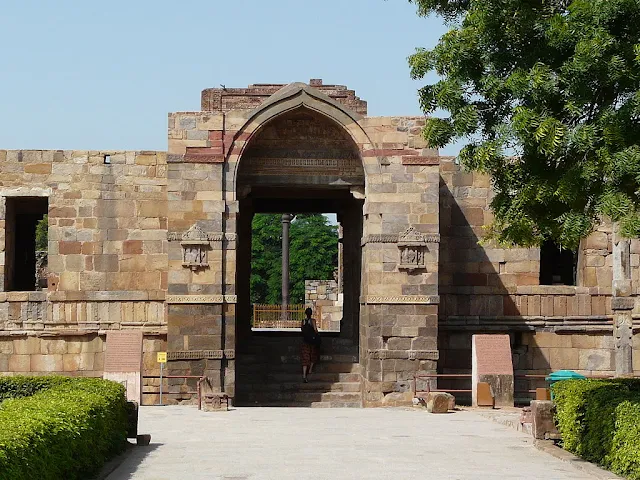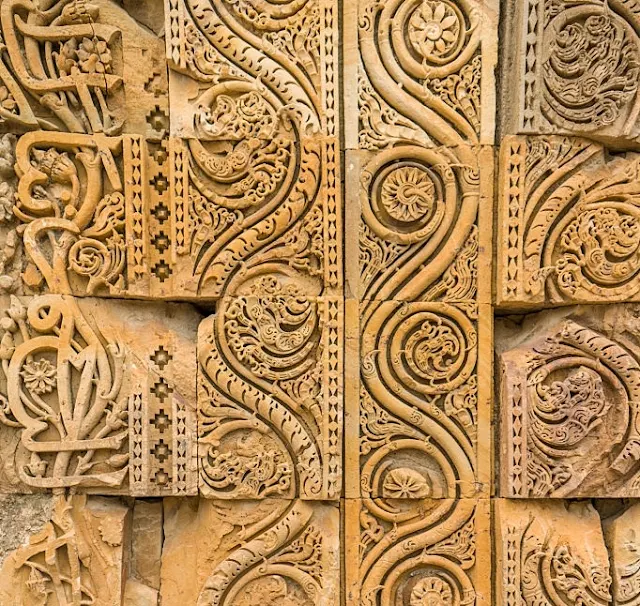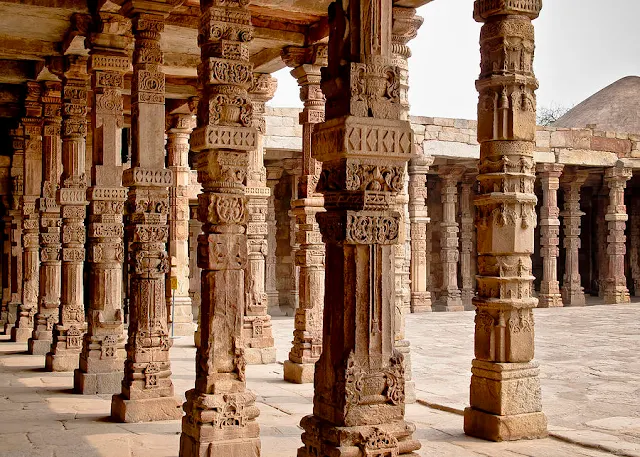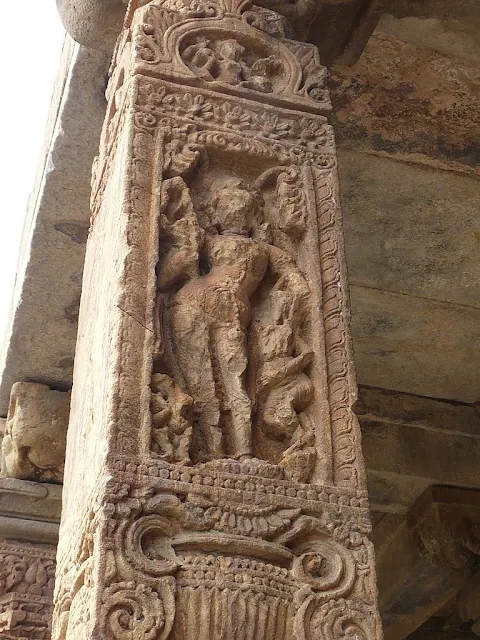Exploring the First Mosque in Delhi, Masjid Quwwat-ul-Islam
The first Mosque in Delhi, known by various names such as Quwwat-ul-Islam and Qutb mosque, holds great historical significance. However, contemporary sources refer to it as the Masjid-i-Jama-i-Hazrat and Masjid-i-Jama-i-Delhi. Originally built by Qutub-ud-din Aibak, the first Muslim ruler of Delhi, this architectural marvel has earned its place on the prestigious UNESCO World Heritage sites list.
Qutb mosque is the first monument built in India by the Delhi Sultans. After the Muslim occupation of Delhi in 1192, Qutub-ud-din Aibak, the favorite slave and commander-in-chief of Muhammad Ghori, laid the foundation of this mosque.
The iconic Qutb Minar served as its mazina, a tower used to sound the Azan, or call for prayers. In the center of the mosque complex stands an awfully enormous Iron Pillar. The Qutb Complex in Mehrauli also encompasses other significant structures, including the Alai Darwaza, tomb of Iltutmish, Alai Minar, Ala-ud-din Khalji's tomb and madrasa and the tomb of Imam Zamin.
The renowned Moroccan traveler Ibn Battuta, who arrived in Delhi during the reign of Muhammad bin Tughlaq in 1334, describes the mosque thus: "The Cathedral mosque occupies a vast area, with its walls, roof and flooring all crafted from white stones that are securely bonded with lead. Not a trace of wood can be found within its structure. The site was formerly occupied by an idol temple, which was converted into a mosque after the city was conquered."
The original mosque of Qutub-ud-din was built as a quadrangle enclosed by colonnades or arcaded cloisters on all four sides. Hindu motifs can still be observed, such as sculpted figures, overflowing kalasa vessels with flowering creepers, bells and chains, and lotus flowers on the pillars.
When the Muslim craftsmen rearranged the exquisitely sculptured columns of the temples, they did not have enough time to properly match the component parts. In some cases, the shaft do not align with the pedestals, as they were originally parts of different pillars.
The grand screen which covers the front of the prayer hall (Mihrab) on the western side, erected by Qutub-ud-din is perhaps the most interesting feature of the mosque. This screen consists of a lofty central arch of ogee shape, flanked by two smaller arches on each side. The arches were constructed using red and yellow sandstone.
The first band is shaped like the arch and contains verses from the Quran. What makes this screen truly remarkable is its intricate ornamentation, depicting serpentine tendrils and undulating leaves. Qutub-ud-din completed these arches in 1197, marking his final contribution to the mosque. The mosque was later extended by Iltutmish (r: 1211-1236) in 1229 and then by Ala-ud-din Khilji (r: 1296-1316) in 1311.
Inscriptions:
The main entrance of the mosque is a domed gate located on the eastern side. This gateway is adorned with the following inscriptions:
"This mosque was built by Qutub-ud-din Aibak. May God's mercy be on him, and on him who prays for a blessing on the faith of the founder of this blessed [edifice]."
"In the name of God, the merciful and benevolent; he who entered it [mosque] has found salvation; for [the favour of] God it is incumbent on all men who have the means [to defray the expenses] of the road, to make a pilgrimage to the House [Kabah] [For him] who has disbelieved [this command], there is no doubt that God is independent of [all that he has] created."
"This fort was conquered and this Jami Masjid was built in the months of the year 589 (AD 1193) by the Amir, the great and glorious commander of the army, Qutb al-Dawla wa'l-Din, the Amiru-l-umara Aibak Sultani, may God strengthen his helpers. The materials of 27 temples, on each of which 2,000,000 Deliwals had been spent, were used in [the construction of] this mosque. May God the great and glorious have mercy on him who should pray for the faith of the good builder."
The inscription on the northern gateway reads thus: "In the name of God, the merciful and the benevolent. God invites [you] to heaven; he directs whomever he pleases on the firm path [of faith]. In the months of the year [5]92 Hijri (AD 1195), this building was commenced by the high command of the great king, great in the world and in faith, Muiz-ud-din Muhammad Bin Sam (Muhammad Ghori), ally of the Amir al-Mu'minin."
Inscription found on a pillar in Aibak's prayer hall, "Under the supervision of the slave Fazl ibn Abul Maali."
Extension of Iltutmish:
Iltutmish almost doubled the size of the mosque by extending the prayer hall and the screen, so that the Qutb Minar now fell within the mosque enclosure.
Extension of Ala-ud-din Khilji:
According to Amir Khusru, Ala-ud-din Khilji 'ordered a fourth court with lofty pillars to be added to the existing three courts (the central court built by Aibak and the two adjacent courts by Iltutmish). Verses from the Quran were engraved on stone as if it was wax. On one side the inscription ascended so high that you would think the word of God was going up to heaven; on the other side it came down in such a way as to symbolize the descent of the Quran to earth'.
The Alai Darwza, the southern gateway of the mosque, stands out as the most remarkable addition made by Ala-ud-din. Unfortunately, both the mosque and the Alai Minar were left incomplete as the Sultan died in 1316.
When Ibn Battuta saw the mosque in 1334, he observed thirteen stone pavilions, a stone pulpit and four courtyards. He also noticed two enormous copper idols near the eastern gate of the mosque, linked by stones. These idols were stepped upon by everyone entering or leaving the mosque.
Firoz Shah Tughlaq (r: 1351-1388) writes in his Memoirs, "The Jami Masjid of Delhi constructed by Sultan Muiz-ud-din Sam was in need of repair and I had it restored so that it became strong again."
However, the passage of time has not been kind to this magnificent structure. Today, it lies in complete ruins, leaving us to ponder the unfortunate fate that has befallen it.
Qutb mosque is the first monument built in India by the Delhi Sultans. After the Muslim occupation of Delhi in 1192, Qutub-ud-din Aibak, the favorite slave and commander-in-chief of Muhammad Ghori, laid the foundation of this mosque.
The iconic Qutb Minar served as its mazina, a tower used to sound the Azan, or call for prayers. In the center of the mosque complex stands an awfully enormous Iron Pillar. The Qutb Complex in Mehrauli also encompasses other significant structures, including the Alai Darwaza, tomb of Iltutmish, Alai Minar, Ala-ud-din Khalji's tomb and madrasa and the tomb of Imam Zamin.
The renowned Moroccan traveler Ibn Battuta, who arrived in Delhi during the reign of Muhammad bin Tughlaq in 1334, describes the mosque thus: "The Cathedral mosque occupies a vast area, with its walls, roof and flooring all crafted from white stones that are securely bonded with lead. Not a trace of wood can be found within its structure. The site was formerly occupied by an idol temple, which was converted into a mosque after the city was conquered."
The original mosque of Qutub-ud-din was built as a quadrangle enclosed by colonnades or arcaded cloisters on all four sides. Hindu motifs can still be observed, such as sculpted figures, overflowing kalasa vessels with flowering creepers, bells and chains, and lotus flowers on the pillars.
When the Muslim craftsmen rearranged the exquisitely sculptured columns of the temples, they did not have enough time to properly match the component parts. In some cases, the shaft do not align with the pedestals, as they were originally parts of different pillars.
The grand screen which covers the front of the prayer hall (Mihrab) on the western side, erected by Qutub-ud-din is perhaps the most interesting feature of the mosque. This screen consists of a lofty central arch of ogee shape, flanked by two smaller arches on each side. The arches were constructed using red and yellow sandstone.
The first band is shaped like the arch and contains verses from the Quran. What makes this screen truly remarkable is its intricate ornamentation, depicting serpentine tendrils and undulating leaves. Qutub-ud-din completed these arches in 1197, marking his final contribution to the mosque. The mosque was later extended by Iltutmish (r: 1211-1236) in 1229 and then by Ala-ud-din Khilji (r: 1296-1316) in 1311.
Inscriptions:
The main entrance of the mosque is a domed gate located on the eastern side. This gateway is adorned with the following inscriptions:
"This mosque was built by Qutub-ud-din Aibak. May God's mercy be on him, and on him who prays for a blessing on the faith of the founder of this blessed [edifice]."
"In the name of God, the merciful and benevolent; he who entered it [mosque] has found salvation; for [the favour of] God it is incumbent on all men who have the means [to defray the expenses] of the road, to make a pilgrimage to the House [Kabah] [For him] who has disbelieved [this command], there is no doubt that God is independent of [all that he has] created."
"This fort was conquered and this Jami Masjid was built in the months of the year 589 (AD 1193) by the Amir, the great and glorious commander of the army, Qutb al-Dawla wa'l-Din, the Amiru-l-umara Aibak Sultani, may God strengthen his helpers. The materials of 27 temples, on each of which 2,000,000 Deliwals had been spent, were used in [the construction of] this mosque. May God the great and glorious have mercy on him who should pray for the faith of the good builder."
The inscription on the northern gateway reads thus: "In the name of God, the merciful and the benevolent. God invites [you] to heaven; he directs whomever he pleases on the firm path [of faith]. In the months of the year [5]92 Hijri (AD 1195), this building was commenced by the high command of the great king, great in the world and in faith, Muiz-ud-din Muhammad Bin Sam (Muhammad Ghori), ally of the Amir al-Mu'minin."
Inscription found on a pillar in Aibak's prayer hall, "Under the supervision of the slave Fazl ibn Abul Maali."
Extension of Iltutmish:
Iltutmish almost doubled the size of the mosque by extending the prayer hall and the screen, so that the Qutb Minar now fell within the mosque enclosure.
Extension of Ala-ud-din Khilji:
According to Amir Khusru, Ala-ud-din Khilji 'ordered a fourth court with lofty pillars to be added to the existing three courts (the central court built by Aibak and the two adjacent courts by Iltutmish). Verses from the Quran were engraved on stone as if it was wax. On one side the inscription ascended so high that you would think the word of God was going up to heaven; on the other side it came down in such a way as to symbolize the descent of the Quran to earth'.
The Alai Darwza, the southern gateway of the mosque, stands out as the most remarkable addition made by Ala-ud-din. Unfortunately, both the mosque and the Alai Minar were left incomplete as the Sultan died in 1316.
When Ibn Battuta saw the mosque in 1334, he observed thirteen stone pavilions, a stone pulpit and four courtyards. He also noticed two enormous copper idols near the eastern gate of the mosque, linked by stones. These idols were stepped upon by everyone entering or leaving the mosque.
Firoz Shah Tughlaq (r: 1351-1388) writes in his Memoirs, "The Jami Masjid of Delhi constructed by Sultan Muiz-ud-din Sam was in need of repair and I had it restored so that it became strong again."
However, the passage of time has not been kind to this magnificent structure. Today, it lies in complete ruins, leaving us to ponder the unfortunate fate that has befallen it.











Comments